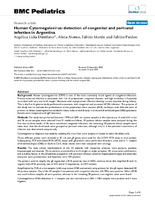Use este identificador para citar ou linkar para este item:
http://sgc.anlis.gob.ar/handle/123456789/413| Título: | Human cytomegalovirus : detection of congenital and perinatal infection in Argentina | Autor(es): | Distéfano, Angélica Alonso, Alicia Martin, Fabián Pardón, Fabián |
Palavras-chave: | Citomegalovirus;Infecciones por Citomegalovirus;Argentina;Pruebas Serológicas;Recién Nacido;ADN Viral | Data do documento: | 2004 | Descrição: | BACKGROUND Human cytomegalovirus (CMV) is one of the most commonly found agents of congenital infections. Primary maternal infection is associated with risk of symptomatic congenital diseases, and high morbidity is frequently associated with very low birth weight. Neonates with asymptomatic infection develop various sequelae during infancy. This is the first Argentine study performed in neonates with congenital and postnatal HCMV infection. The purpose of this study was to evaluate the performance of the polymerase chain reaction (PCR) technique with different pairs of primers, to detect cytomegalovirus isolated in tissue cultures and directly in urine and dried blood spot (DBS) specimens. Results were compared with IgM detection. METHODS The study was performed between 1999 and 2001 on routine samples in the Laboratory. A total of 61 urine and 56 serum samples were selected from 61 newborns/infants, 33 patients whose samples were analyzed during the first two to three weeks of life were considered congenital infections; the remaining 28 patients whose samples were taken later than the third week were grouped as perinatal infections, although only in 4 the perinatal transmission of infection was determined unequivocally. Cytomegalovirus diagnosis was made by isolating the virus from urine samples in human foreskin fibroblast cells. Three different primer pairs directed to IE, LA and gB genes were used for the HCMV PCR assay in viral isolates. Subsequently, PCR and nested PCR (nPCR) assays with gB primers were performed directly in urine and in 11 samples of dried blood spot (DBS) on Guthrie Card, these results were then compared with serology. RESULTS The main clinical manifestations of the 33 patients with congenital infection were purpura, jaundice, hepatomegaly and anaemia. Three patients presented low birth weight as single symptom, 10, intracranial calcifications, and 2, kidney failure. In the 28 patients grouped as with perinatal infection, anaemia, hepatosplenomegaly and enzymatic alteration were predominant, and 4 patients were HIV positive. The primers used to amplify the gB region had a PCR positivity rate of 100%, whereas those that amplified IE and LA regions had a PCR positivity rate of 54% and 61% respectively, in CMV isolates. Amplification by PCR of urine samples (with no previous DNA extraction), using primers for the gB region, detected 34/61 positive samples. Out of the 33 samples from patients with congenital infection, 24 (73%) were positive. When nPCR was used in these samples, all were positive, whereas in the remaining 28 patients, two negative cases were found. Cytomegalovirus DNA detection in 11 samples was also carried out in DBS: 7 DBS samples were positive and 4 were negative. CONCLUSIONS Primers directed to the gB fragment region were the best choice for the detection of CMV DNA in positive isolates. In congenital infections, direct PCR in urine was positive in a high percentage (73%) of samples; however, in patients grouped as with perinatal infection only 36% of the cases were positive. With n-PCR, total sample positivity reached 97%. PCR technique performed in DBS allowed identifying congenital infection in four patients and to be confirmed in 3. These results show the value of nPCR for the detection of all cases of CMV infection. The assay offers the advantage that it may be performed within the normal working day and provides reliable results in a much shorter time frame than that required for either traditional tissue culture or the shell-viral assay. Fil: Distéfano, Angélica. ANLIS Dr.C.G.Malbrán. Instituto Nacional de Enfermedades Infecciosas. Instituto Nacional de Microbiología. Laboratorio de Virosis Congénitas Perinatales y Transmisión Sexual. Departamento de Virología; Argentina. Fil: Alonso, Alicia. ANLIS Dr.C.G.Malbrán. Instituto Nacional de Enfermedades Infecciosas. Instituto Nacional de Microbiología. Laboratorio de Virosis Congénitas Perinatales y Transmisión Sexual. Departamento de Virología; Argentina. Fil: Martin, Fabián. ANLIS Dr.C.G.Malbrán. Instituto Nacional de Enfermedades Infecciosas. Instituto Nacional de Microbiología. Laboratorio de Virosis Congénitas Perinatales y Transmisión Sexual. Departamento de Virología; Argentina. Fil: Pardón, Fabián. ANLIS Dr.C.G.Malbrán. Instituto Nacional de Enfermedades Infecciosas. Instituto Nacional de Microbiología. Laboratorio de Virosis Congénitas Perinatales y Transmisión Sexual. Departamento de Virología; Argentina. |
URI: | http://www.biomedcentral.com/content/pdf/1471-2431-4-11.pdf http://sgc.anlis.gob.ar/handle/123456789/413 |
ISSN: | 1471-2431 | Direitos: | info:eu-repo/semantics/openAccess |
| Aparece nas Coleções: | snrd Publicaciones INEI |
Arquivos neste item:
| Arquivo | Descrição | Tamanho | Formato | |
|---|---|---|---|---|
| BMCPediatrics2004,(4),11..pdf | 838.87 kB | Adobe PDF |  Ver/Aberto |
Visualização de página
162
Checado em 15/12/2025
Download(s)
93
Checado em 15/12/2025
Google ScholarTM
Checar
Os itens no repositório estão protegidos por copyright, com todos os direitos reservados, salvo quando é indicado o contrário.

